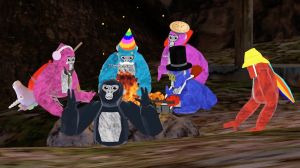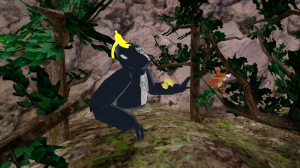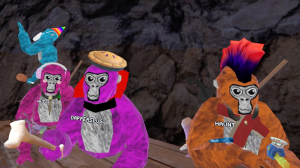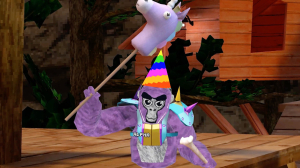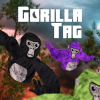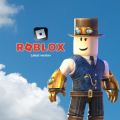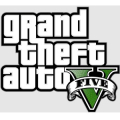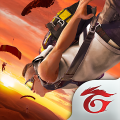Gorilla Tag
There’s something immediately captivating about Gorilla Tag. It doesn’t rely on hyper-realistic graphics or convoluted storylines—instead, it strips everything back to movement, interaction, and pure chaos. Loading it up for the first time, you instantly sense that this is not your standard VR fare. If you came searching for a showcase title boasting dazzling visuals, you might initially blink in surprise. The chunky, low-poly gorillas and simple environments aren’t here to wow, but rather to focus players solely on gameplay. And in Gorilla Tag, that gameplay is nothing short of exhilarating.
Gameplay: Hands-On Primal Fun
Forget joysticks and conventional VR locomotion tricks. Gorilla Tag is all about authentic, physical movement. You swing, push, and bounce yourself around the world using only your hands—no controllers, no tricks. This approach might sound simple, but the sensation is transformative.
You use your arms like a gorilla would, propelling yourself across forests, canyons, and increasingly creative maps. Chasing another player while they desperately scramble away, or dashing for safety from a tagger who just cornered you in a tree, generates a level of frantic energy few games can match.
There’s no automated running or gliding; everything depends on your own physical skill. This also means there’s a steep learning curve. Your first few rounds might end in clumsy tumbles and flailing, but mastery comes surprisingly quickly—and with it, a sense of freedom that only VR can provide. That’s Gorilla Tag’s magic: it feels like a game you can teach yourself, one factored purely on your desire to improve.
Community: Open, Chaotic, and Surprising
The Gorilla Tag community is wild and vibrant. Since the game is free, there’s a constantly refreshed pool of players of all ages and skill levels. Social interaction here is direct (and often hilarious). With no in-game text or private messaging, communication is all vocal and face-to-face—flinging banana jokes, shouting warnings, and coordinating with allies, you feel present, immersed, and exposed in a way most online multiplayer titles can’t replicate.
The chaotic nature can be hit-or-miss, however. While most players are friendly and energetic, the open mic aspect sometimes leads to the kind of unfiltered chatter you’d expect from an open lobby. But that’s part and parcel of such an open-ended, low-barrier multiplayer game.
Game Modes: Simplicity as Strength
On paper, Gorilla Tag couldn't be simpler. There’s a classic game of tag: if you’re tagged, you join the ranks of the chasers. Variations—like Infection mode—add twists, but the foundation remains unchanging.
It works because the action itself is so satisfying, and the maps (though primitive in visual style) are meticulously designed for climbing, leaping, and darting. The sense of verticality and hidden spots is outstanding. Maps encourage you to take risks, to leap for branches or scamper through cramped tunnels, leading to heart-pounding escapes and last-second tags.
Despite its simplicity, players keep returning. This addictive loop is a testament to the movement and emergent social play that radiates from Gorilla Tag.
Download, Install, and Accessibility
One of Gorilla Tag’s triumphs is availability. As a free download, you can dive in without financial commitment—which is rarely the case with VR games of this caliber. Installation is painless, especially on supported platforms. Oculus Quest users can grab it from App Lab, and PC VR players simply fetch it from Steam. This straightforward access removes many barriers to entry, making it perfect for VR beginners and seasoned enthusiasts alike.
Some players seek ways to access Gorilla Tag unblocked in environments like school or work. While official versions are not blocked, network restrictions and device limitations may pose hurdles. Some workaround methods do exist, but the genuine fun relies on room-scale VR play with ample space.
Platforms: Where Can You Play?
Currently, Gorilla Tag is tailored for VR devices. Oculus Quest (both Quest 1 and Quest 2), PC VR via SteamVR, and recently, Meta’s expanded support encompass the key platforms. PlayStation VR and console editions remain unavailable as of now, and there’s no browser or mobile-native release. For those desperate to play on Mac or Chromebook hardware, cloud streaming or emulation aren’t practical solutions—VR is mandatory, and nothing matches original hardware performance. This focus affirms Gorilla Tag’s dedication to immersive, embodied play.
Cheats and Mods: Creative Expansion or Unfair Play?
The popularity of Gorilla Tag has spawned a lively modding community. The original developer has been remarkably open, allowing certain mods while staying vigilant against exploitative cheats that ruin competitive play. There’s a clear line: cosmetic mods that alter appearance or inject creative flair (custom maps, visual overhauls) are generally encouraged in private lobbies, while cheats that break game balance are aggressively targeted and lead to bans.
For new players, installing quality mods is a way to keep the experience fresh, but vanilla play is where the balanced action is. This balanced attitude gives the community room to innovate without sacrificing the core gameplay that makes the title great.
Graphics and Audio: Minimalist, Functional, and Nostalgic
Visually, Gorilla Tag makes no secret of its simplicity. The environments are basic, with vibrant blocks of color and minimal texturing. Yet it all comes together to serve the gameplay. The low-fi aesthetic keeps performance high, which is crucial in a demanding VR setting. Sound design does a lot of heavy lifting—subtle environmental cues, the thudding of hands hitting virtual ground, and the echoes of laughter and chatter bring the primitive world to life.
You won’t find the latest lighting effects or dense geometry, but Gorilla Tag compensates by letting players’ energy fill the gaps. The playful, community-driven environments have a distinct personality all their own.
Free-To-Play: Accessibility and Monetization
Crucially, Gorilla Tag is completely free to download and play. The developer monetizes via optional cosmetics and support packs. Nothing is locked behind paywalls or progression gates—in-game purchases are strictly for looks, with no gameplay advantage. This keeps the experience fair regardless of whether you spend money.
Being free also means that Gorilla Tag attracts genuine curiosity and experimentation. You can easily invite friends—no complex installs, no hidden fees. This spirit of accessibility is why the user base remains lively months and years after launch.
Final Thoughts: A VR Standout for Pure Fun
Gorilla Tag isn’t about shiny surfaces or deep narratives. It’s about movement, mastery, and that buzz of connection as you swing triumphantly past your friends or strangers. Few games in VR—or anywhere—distill play down to its raw, unfiltered essence this effectively. Whether diving in for a few rounds at the end of a long day or chasing the rush of outwitting an entire lobby, you’ll find Gorilla Tag always offering another reason to keep playing. If you want a title you can download, play for free, and share laughter and chaos with total strangers (or close friends), Gorilla Tag is easily among your best bets in modern VR.
How to Download and Play Gorilla Tag on Different Platforms
Gorilla Tag is a free-to-play VR multiplayer game that emphasizes physical movement and social interaction. No matter your chosen device, getting started is easy if you have compatible hardware and enough room to move safely.
- Windows PC: Fully supported for VR via Steam. You can install Gorilla Tag through the Steam store (SteamVR required).
- Mac: Not supported natively. VR gaming is generally limited by hardware and lack of official support.
- Chromebook: Not officially supported. VR play is not available through cloud gaming and Chromebook hardware is incompatible.
- Meta Quest (Quest 1 & 2): Available for free via App Lab or SideQuest. Direct wireless install is possible.
- PlayStation 5/PlayStation 4: Currently unavailable. There are no supported versions for these platforms.
- Xbox One/Xbox Series X|S/Xbox 360: Not available.
- Nintendo Switch: Unavailable.
To install Gorilla Tag, simply search for it on the Steam store or Meta App Lab, then download and follow the prompts. Make sure you have enough play space for room-scale VR action.
On Windows PC, the minimum requirements include a VR-ready headset (like Oculus Rift, HTC Vive, or Valve Index), an Intel i5-4590 processor or better, 4 GB RAM, and a GTX 970 GPU or equivalent. Meta Quest devices require recent system software and enough storage for the download.
Cheats are not allowed in Gorilla Tag’s public lobbies, and using unauthorized cheats can result in being banned. Cosmetic mods are permitted in private rooms, but always install mods with care and follow community guidelines.
For unblocked play in places like school or work, Gorilla Tag generally cannot be accessed without your own VR hardware and the necessary software permissions. Workarounds aren’t officially endorsed and may violate network policies.
- Immersive, physically engaging VR movement you won’t find elsewhere
- Easy to download and install on modern VR headsets
- Free-to-play model maximizes accessibility with zero pay-to-win mechanics
- Active, inventive modding community with custom maps and visual tweaks
- Endlessly replayable—emergent fun with new players every session
- Maps and modes are well-tuned for heart-racing chases and escapes
- Low minimum system requirements make it approachable for budget VR setups
- Basic graphics and simple environments may turn off players seeking visual wow-factor
- Can be physically demanding
- not recommended for those with limited mobility
- Occasional toxic behavior in open mics or unsupervised online lobbies
